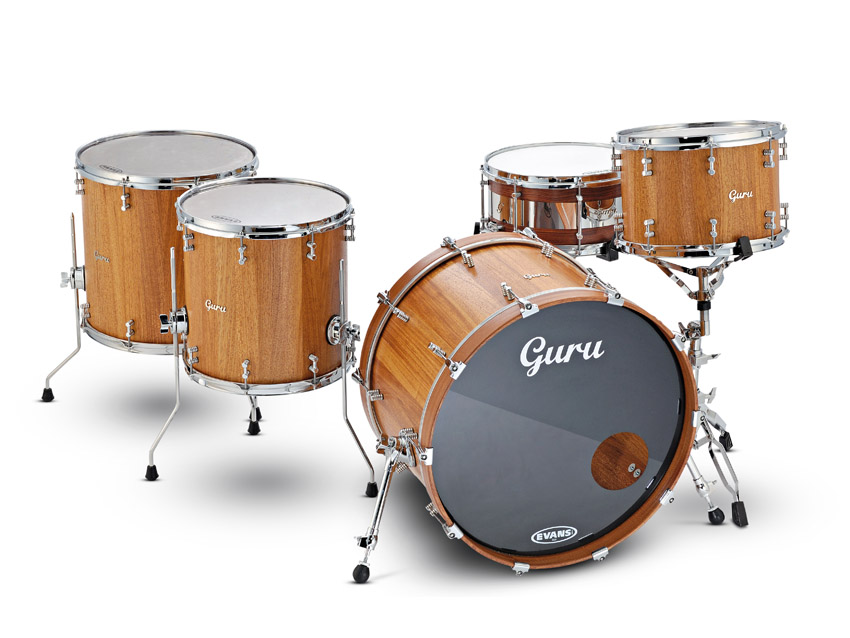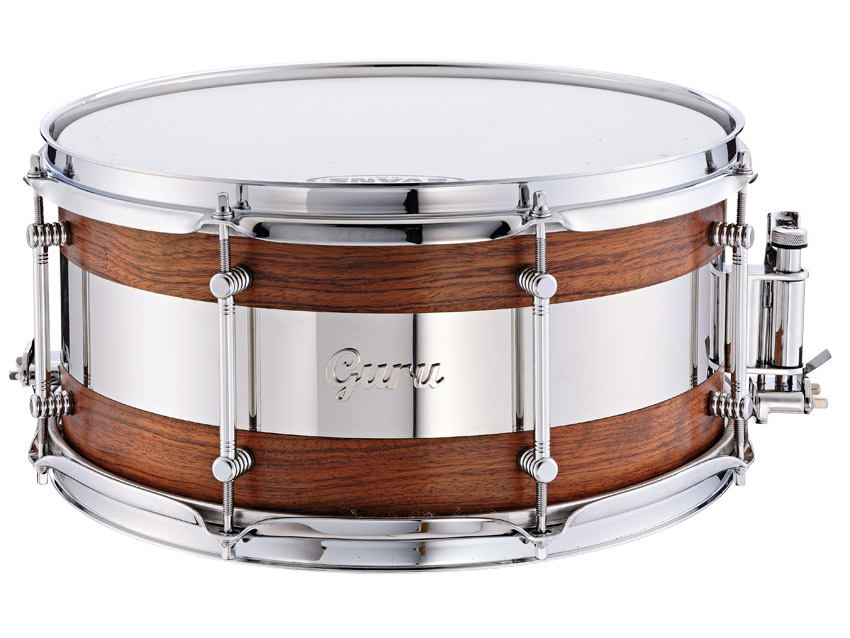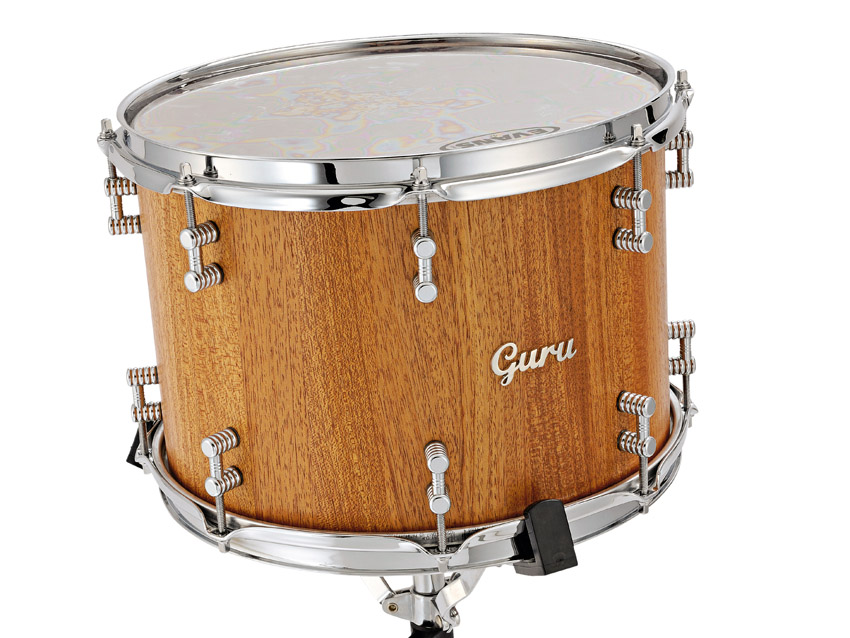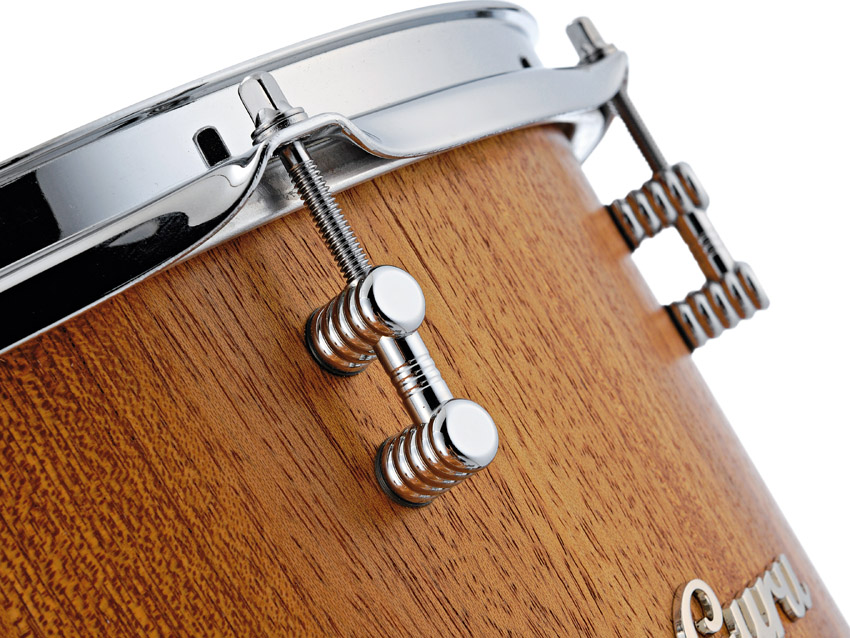MusicRadar Verdict
Guru offers a great range of exotic timbers from sustainable sources. Prices are realistic and a one-off boutique kit is an increasingly attractive alternative.
Pros
- +
Craftsmanship and build quality. Individual character. Great snare.
Cons
- -
Heavyweight kit won't suit everybody.
MusicRadar's got your back

Guru Drumworks Kit

Guru Drumworks Kit

Guru Drumworks Kit

Guru Drumworks Kit
Guru Drumworks is the name chosen by Stockton-On-Tees carpenter Dean Price for his hand-made, boutique-style drums. Dean started out making stave shells seven years ago and has added steam bending of single-ply boards with solid reinforcing rings in the past two years.
This means the drums are close to having solid shells, with a much-reduced resonance-inhibiting glue content. Guru claims that the amount of glue used in stave shells is 0.01 percent of that used in ply shells.
Build
Our review kit exemplifies both shell-making techniques, with a snare which has a steam-bent bubinga shell and toms and bass built from vertical staves of solid, 10mm thick mahogany. The bass drum also has hoops which are steam-bent from the same mahogany.
"The combined effect is a more rounded, upper-mid range sound, penetrating but with less of an initial cutting edge compared with today's conventional drums."
And this mahogany is special, since Dean managed to reclaim it from flooring in Dalegarth Manor, Hartlepool. "I've been making things for the guy there," Dean explains, "and he'd got mahogany floorboards which he ripped up. I kept the wood, as it is close to 100 years old and quality seasoned. Wood like that is just not available in today's timber market. So this kit is part of my limited-run Dalegarth series."
The kit consists of 22"x14" bass drum, 16"x16" and 14"x14" floor toms with legs and a 13"x8" undrilled rack tom. The shells have vintage-style rounded bearing edges and are finished in a tough, water-clear polyurethane lacquer, sprayed on to leave the natural wood's texture on show.
The lacquer sinks right into the grain so it does not have a glassy shine but is really hard wearing. Dean says that you can simply wipe it with warm water to keep it clean, or use a good furniture polish.
Guru offers a variety of finishes in hand-rubbed oils and clear lacquers. Guru has its own design, twin point-mounted tube lugs, specially made in Taiwan, which have nicely detailed ribbing. These come as standard on all drums.
The number of staves making up each shell depends on lug configuration - an eight-lug drum has 16 staves, a 10-lug has 20, and so on. The eight-lug 14"x6" snare drum is an unusual hybrid of wood and steel.
The wood component is steam-bent from a single plank of 6mm thick bubinga with solid 8mm bubinga reinforcing hoops. The joins are long scarf joints, with perfectly smooth overlaps. Built in two halves, top and bottom, the wood shell is connected in the middle by a 6cm (23/8") deep cylinder of 18 gauge stainless steel, which Guru can supply in polished or brushed finish.
Dean has access to a CNC (computer numerical controlled) lathe cutter for super-accurate steel cutting, so he took the opportunity to experiment with a hybrid shell. The steel also bears the stylish Guru script logo and has an elegant, laser-cut 'G' air vent, plus laser engraved serial number. Customers can request specific laser-cut text for their drum.
Completing the snare is a Dunnett 'R' series strainer, PureSound Blaster snare wires and choice of Evans heads - in this case ST Dry batter and Hazy 200 resonant.
Hands On
The first thing you notice about these drums is the weight of the luxurious seasoned solid mahogany. Most drum companies today subscribe to the 'thin equals resonant and deep' school, whereas these drums are the opposite.
"Whichever way I turned the snare - high or low, tight snares or slack - it sounded lively and full of character. The more I played it, the more I loved it."
Thick shells heighten pitch and are sonically more neutral, ie: stable, than thin resonant shells, allowing the sound character of the chosen heads to feature more.
This is counteracted somewhat by the fact that Dean has chosen to cut vintage-style, partially-rounded bearing edges on the toms and completely rounded edges on the bass drum. Thus more of the head is in contact with the wood than usual, giving you the woody character of the shell along with reduced attacking bite.
Dean has fitted the toms with twin-ply Evans G2 batters (with G1 resonants) and the bass drum with an Evans EQ4 batter. The combined effect of all this is a more rounded, upper-mid range sound: penetrating but with less of an initial cutting edge compared with most of today's conventional drums. It makes a nice change for reviewing since most modern drums sound broadly the same.
The narrow, retro-depth 14" bass drum has a classic hard-nosed jazz or old-school 'bonk'. It suits the vintage mahogany, but be aware - it is again different from today's 20" deep thudders. There is a definite pitch and a bruising timbre, with less of the spiky click which characterises today's more usual deep-shelled bass drums with their sharpened bearing edges.
This might take some getting used to, and we admit we swapped the fitted EQ4 batter for an Aquarian SuperKick-1 for a slightly fatter, darker and wetter sound.
Overall, the kit has a dry-ish, tough and bright tone with formidable clout. Singly the toms and kick may initially appear severe, but played as a whole the sound is balanced, melodic and penetrating.
While the blunt-ish tone of the toms and bass drum took some acclimatising to, the snare drum was an immediate hit. There is an unmistakable metallic component to the sound which is tempered and rounded out by the bubinga. Although the (superb) edges this time are more standard 45° cuts, they are still slightly rounded over, not brought to a sharp lip like most modern snares.
This has the effect of fattening the sound, leading to a compromise between the abrasive snare-iness and the warm woodiness. The snare beds are also carefully cut, graduated to 1.7mm deep, while the Dunnett strainer and PureSound snare wires are top class.
Whichever way we tuned the drum - high or low, tight snares or slack - it sounded lively and full of character. The more we played it, the more we loved it. We felt it was more versatile than the rest of the kit - you could play any style of music with this drum.
Once again we have a magnificent example of modern British craftsmanship. But be prepared for a heavyweight kit and more importantly a slightly different type of sound.
Thick stave shells mean elevated pitches and the rounded bearing edges give a warmer, more middly sound. Dean will cut sharp bearing edges but suggests that vintage timber suits vintage edges.
“Sometimes I am two people. Johnny is the nice one. Cash causes all the trouble. They fight”: How Johnny Cash drew on his own experiences to make his greatest songs
“For those on the hunt for a great quality 12-string electro-acoustic that won’t break the bank, it's a no-brainer”: Martin X Series Remastered D-X2E Brazilian 12-String review
“I have that on more records than anything else”: Take a peek inside Vaughn Oliver’s studio









